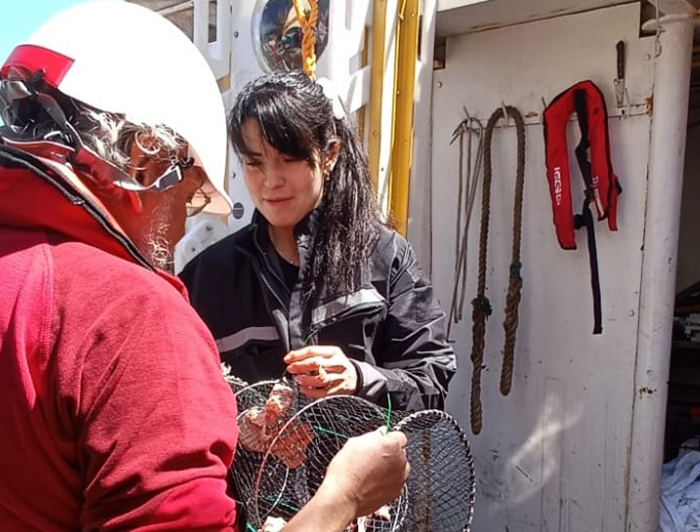The team last September Millennium Institute of Oceanography (IMO), They announced the end of their successful voyage aimed at launching a deep-ocean monitoring system, which they installed in the Atacama Trench, off the coast of Antofagasta.
It is called the Deep Ocean, Earthquake and Tsunami Observatory Eidos (abbreviated in English), is the first well-established monitoring system in the deep ocean and its goal is to study the structure and diversity of the physical, geochemical and biological conditions of the region.
This interdisciplinary work will allow us to discover, measure and understand the different processes that occur at these great ocean depths. This means that, for the first time in the history of marine science, it will be possible to build a scientific base that will eventually create a national monitoring system for climate change; Or even placing the country on the frontier of oceanographic and seismic research at the international level: something very important for a coastal and seismic country like Chile.
“The deep ocean remains one of the least explored places on Earth, and today we can say that we are one step ahead of Chile with the latest technology and research” – Peter von Dassow, researcher at the School of Biological Sciences.
For IDOOS to achieve its goal, strong national and international cooperation is needed to plan the various oceanographic expeditions. That is why different institutions such as the University of Concepcion and Antofagasta are involved in the project; Pontifical Catholic University of Valparaiso and Universidade Austral de Chile in collaboration with GEOMAR (Helmholtz Center for Ocean Research in Kiel, Germany) and HADAL (Danish Hadal Research Center in Odense, Denmark).
The least explored place on earth
The monitoring system consists of two main components: an array of five seafloor pressure and tilt sensors with the ability to measure vertical displacements of the ocean floor and make observations on land where large earthquakes occur. It consists of an array of oceanographic sensors located at depths of up to 7,500 meters below the sea surface.
To implement these elements, IMO engineers and technicians, together with… Center for Ocean Instruments (CIO)A new lander (a type of unmanned autonomous vehicle) has been designed, led by Dr. Marcos Moreno, from the Department of Geophysics at the University of California, and oceanographer Nadine Ramirez. In this context, as a co-researcher, the academician from the university supports this feat. Faculty of Biological Sciences of the Pontifical Catholic University of Chile, Dr. Peter von Dassow.
Marine biology graduates
On this latest expedition carried out in September on board the scientific vessel Abate Molina, Dr. Peter von Dassow was represented by Sibylle Amestica and Dr. Carolina González: both graduates of the Institute. degree in Marine Biology from the UCLA School of Biological Sciences.
In a mission that took about two weeks and was extremely complex from a technical and climatic standpoint, marine biologists sailed into the depths of northern Chile, where they were able to learn first-hand about the project. “The professor trusted us because we performed well in his course, as well as being his teaching assistants, which allowed us to get to know each other better and establish a stronger collaborative relationship for research,” says Carolina Gonzalez.
Interdisciplinary exploration
this Fundequip project It managed to bring together distinguished scientific communities, which until now had been working in parallel UDCBut thanks to this project they will start to cooperate synergistically. “On the one hand, there is the entire oceanographic community, made up of oceanographers. On the other hand, there is the geophysical community that works on plate tectonics and earthquakes. “We were the first environmental biologists to do this,” adds Sibyl Amestica.
On the first voyage, sensors were installed which are motion detectors and on the second voyage, anchors were installed to see the water column. “We left on September 26 with the materials, and in the early morning of September 27, we had to load all the materials. Despite the bad weather conditions, we were able to complete the deployment, which was the most important thing,” Sibyl recalls.
For both Karolina and Sibyl, the camaraderie that was created allowed them to successfully carry out their related experiments Zooplankton And with Benthic amphipods. “In my case, I highlight the efficiency of collecting organisms, which allowed us to properly preserve them and study their metabolism in the future,” explains Sybil. On the other hand, for Carolina, working with the obtained specimens allowed her to “collect two new species of benthic amphipods in the trench, although verification by tectonic and molecular analyzes still needs to be done.”
From the researchers’ point of view, this project is relevant, because it provides the opportunity to understand how organisms adapt to low oxygen concentrations. “These missions are of great importance, because they encourage us to conduct interdisciplinary exploration involving engineers, geophysicists and marine biologists, which will allow us to reveal adaptation to the ocean environment in a more complete way,” says Carolina.

“Social media evangelist. Student. Reader. Troublemaker. Typical introvert.”




:quality(85)/cloudfront-us-east-1.images.arcpublishing.com/infobae/SXDWOIO7O5FMZOWUATFEXQYWTY.jpg)


More Stories
National Academy of Medicine and PAHO present reports of the Colombia General Physician Competency Forum – PAHO/WHO
Academic excellence in medical sciences is recognized at Granma.
Medical simulation has revolutionized the training of doctors in the country.